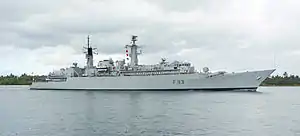HMS Beaver (F93)
HMS Beaver was one of 10 Type 22 missile frigate of the Broadsword Class ordered by the Royal Navy.[1]
 HMS Beaver | |
| History | |
|---|---|
| Name: | HMS Beaver |
| Operator: | Royal Navy |
| Builder: | Yarrow Shipbuilders |
| Laid down: | 20 June 1980 |
| Launched: | 8 May 1982 |
| Commissioned: | 13 December 1984 |
| Decommissioned: | 1 May 1999 |
| Identification: | Pennant number: F93 |
| Fate: | Sold for scrap 21 February 2001 |
| General characteristics | |
| Displacement: | 4,800 tons |
| Length: | 146.5 m (481 ft) |
| Beam: | 14.8 m (49 ft) |
| Draught: | 6.4 m (21 ft) |
| Propulsion: |
|
| Speed: |
|
| Range: | 8,000 nmi (15,000 km; 9,200 mi) |
| Complement: | 273 |
| Armament: |
|
| Aircraft carried: | 2 × Lynx MK 8 helicopters |
The ship was laid down at the Yarrow Shipbuilders Ltd., Scotstoun, on 20 June 1980 and finally commissioned on 13 December 1984. Originally 22 ships of the class were planned to be built, but after the Falklands War, it was decided 10 was enough.[2]
Power & Complement
With a maximum displacement of 4800 tons and a crew complement of 273 hands,[3] HMS Beaver had a propulsion of 54,000HP from 2 Rolls Royce gas turbine Olympus TM3B and 2 Rolls Royce gas turbine Tyne RM1C engines, a maximum speed of 30 Knots and a range of 4,500 Nautical Miles.[2]
Armaments & Equipment

Armaments included:
- 4 × Exocet MM38 missiles[3]
- 2 Seawolf SAM missile launchers - 6 missiles per launcher
- 4 30 mm GCM-A03 guns
- 2 20 mm GAM-B01 guns
- 6 × 324 mm ASW torpedo tubes[2]
On top of this HMS Beaver could carry 2 Lynx HMA 8 helicopters.[3]
Other equipment included:
Bolton's Adoption
HMS Beaver was the adopted ship of the town of Bolton. Despite being many miles inland the town has a proud naval tradition based on the fact that during one week in the Second World War it raised one million pounds for the Royal Navy. The sixth HMS Dido was officially adopted by the town during the war to mark this honour.
Prior to decommissioning, it was possible for Beaver Scouts to become honorary members of the crew.
Decommissioning and fate
On 1 May 1999, HMS Beaver was decommissioned and then sold for scrap on 21 February 2001.[2]
Commanding officers
| From | To | Captain |
|---|---|---|
| 1984 | 1985 | Captain John S Lang RN |
| 1985 | 1987 | Captain Norman Dingemans RN |
| 1987 | 1988 | Captain Geoffrey A. Eades RN |
| 1988 | 1988 | Captain Andrew B Gough RN |
| 1988 | 1990 | Captain Anthony Morton RN |
| 1990 | 1993 | Commander C P R Montgomery RN |
| 1993 | 1994 | Captain Christopher Clayton |
| 1994 | 1996 | Commander Philip Jones RN |
| 1996 | 1997 | Captain David Lewis RN |
References
- "TYPE 22 BROADSWORD (BOXER ) CLASS FRIGATES". worldnavalships.com. Retrieved 26 October 2012.
- "FFG - HMS Beaver (F93) :: Frigates :: United Kingdom (GBR)". en.valka.cz. Retrieved 26 October 2012.
- "F93 HMS Beaver". helis.com. Retrieved 26 October 2012.
- Mackie, Colin. "II: Royal Navy- Captains Commanding Warships". British Armed Forces (1900–). Retrieved 19 January 2014.
Publications
- Colledge, J. J.; Warlow, Ben (2006) [1969]. Ships of the Royal Navy: The Complete Record of all Fighting Ships of the Royal Navy (Rev. ed.). London: Chatham Publishing. ISBN 978-1-86176-281-8.